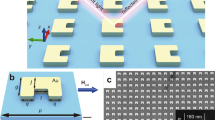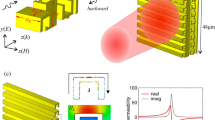Abstract
Complete control of an electromagnetic wave requires access to its electric and magnetic vector components. Realizing this level of control with metamaterials has recently opened new avenues regarding negative refractive indices1,2 and invisibility cloaking3,4. The required microscopic building blocks are artificial electric and magnetic dipoles. Magnetic dipoles oscillating at optical frequencies have become available only recently in the form of man-made split-ring resonators5, essentially subwavelength resonant electromagnets. Previous experimental work has focused on arrays of electric and/or magnetic dipoles1,2,6,7. For further developments in this field, knowledge of the properties of the individual dipoles is highly desirable. In this paper, using a modulation technique8,9, we measure the absolute extinction cross-section of a single split-ring resonator for the first time. At the fundamental magnetic resonance, it is found to be about one-seventh of λ2 at a wavelength of λ = 1.4 µm, which is in excellent agreement with microscopic calculations.
This is a preview of subscription content, access via your institution
Access options
Subscribe to this journal
Receive 12 print issues and online access
$209.00 per year
only $17.42 per issue
Buy this article
- Purchase on Springer Link
- Instant access to full article PDF
Prices may be subject to local taxes which are calculated during checkout



Similar content being viewed by others
References
Shalaev, V. M. Optical negative-index metamaterials. Nature Photon. 1, 41–48 (2007).
Soukoulis, C. M., Linden, S. & Wegener, M. Negative refractive index at optical wavelengths. Science 315, 47–49 (2007).
Pendry, J. B., Schurig, D. & Smith, D. R. Controlling electromagnetic fields. Science 312, 1780–1782 (2006).
Schurig, D. et al. Metamaterial electromagnetic cloak at microwave frequencies. Science 314, 977–980 (2006).
Pendry, J. B., Holden, A. J., Robbins, D. J. & Stewart, W. J. Magnetism from conductors and enhanced nonlinear phenomena. IEEE Trans. Microwave Theory Tech. 47, 2075–2084 (1999).
Linden, S. et al. Magnetic response of metamaterials at 100 Terahertz. Science 306, 1351–1353 (2004).
Enkrich, C. et al. Magnetic metamaterials at telecommunication and visible frequencies. Phys. Rev. Lett. 95, 203901-1 (2005).
Arbouet, A. et al. Direct measurement of the single-metal-cluster optical absorption. Phys. Rev. Lett. 93, 127401-1 (2004).
Muskens, O. L. et al. Single-metal nanoparticle absorption spectroscopy and optical characterization. Appl. Phys. Lett. 88, 063109-1 (2006).
Shamonina, E. & Solymar, L. Properties of magnetically coupled metamaterial elements. J. Magn. Magn. Mater. 300, 38–43 (2006).
Dolling, G., Wegener, M., Schädle, A., Burger, S. & Linden, S. Observation of magnetization waves in negative-index photonic metamaterials. Appl. Phys. Lett. 89, 231118–231120 (2006).
Liu, N. et al. Three-dimensional photonic metamaterials at optical frequencies. Nature Mater. 7, 31–37 (2008).
Sönnichsen, C., Franzl, T., Wilk, T., von Plessen, G. & Feldmann, J. Drastic reduction of plasmon damping in gold nanorods. Phys. Rev. Lett. 88, 077402-1 (2002).
Bohren, C. F. & Huffman, D. R. Absorption and Scattering of Light by Small Particles (Wiley, New York, 1983).
Rockstuhl, C. et al. On the reinterpretation of resonances in split-ring-resonators at normal incidence. Opt. Express 14, 8827–8836 (2006).
Engheta, N. Circuits with light at nanoscales: optical nanocircuits inspired by metamaterials. Science 317, 1698–1702 (2007).
Meyrath, T. P., Zentgraf, T. & Giessen, H. Lorentz model for metamaterials: optical frequency resonance circuits. Phys. Rev. B 75, 205102-1 (2007).
Busch, K. et al. Periodic nanostructures for photonics. Phys. Rep. 444, 101–202 (2007).
Johnson, P. B. & Christy, R. W. Optical constants of the noble metals. Phys. Rev. B 6, 4370–4379 (1972).
Taflove, A. & Hagness, S. C. Computational Electrodynamics: The Finite-Difference Time-Domain Method 3rd edn (Artech House, Boston, 2005).
Acknowledgements
We thank Costas M. Soukoulis for discussions. We acknowledge the support of the Deutsche Forschungsgemeinschaft (DFG) and the State of Baden-Württemberg through the DFG-Center for Functional Nanostructures (CFN) within subprojects A1.2, A1.5, A5.2 and A5.3 as well as by the BMBF-Verbund METAMAT and by the European Union project PHOME. The research of S.L. is also supported through a Helmholtz-Hochschul-Nachwuchsgruppe (VH-NG-232). The PhD research of N.F., M.K. and J.N. is further supported by the Karlsruhe School of Optics and Photonics (KSOP).
Author information
Authors and Affiliations
Corresponding author
Rights and permissions
About this article
Cite this article
Husnik, M., Klein, M., Feth, N. et al. Absolute extinction cross-section of individual magnetic split-ring resonators. Nature Photon 2, 614–617 (2008). https://doi.org/10.1038/nphoton.2008.181
Received:
Accepted:
Published:
Issue Date:
DOI: https://doi.org/10.1038/nphoton.2008.181
This article is cited by
-
Recent advances in tip-enhanced Raman spectroscopy probe designs
Nano Research (2023)
-
Polarization contrast scattering spectroscopy of individual metal nanoantennas
Applied Physics B (2017)
-
The local density of optical states of a metasurface
Scientific Reports (2016)
-
Plasmonic meta-atoms and metasurfaces
Nature Photonics (2014)
-
Broadband absorption engineering of hyperbolic metafilm patterns
Scientific Reports (2014)



